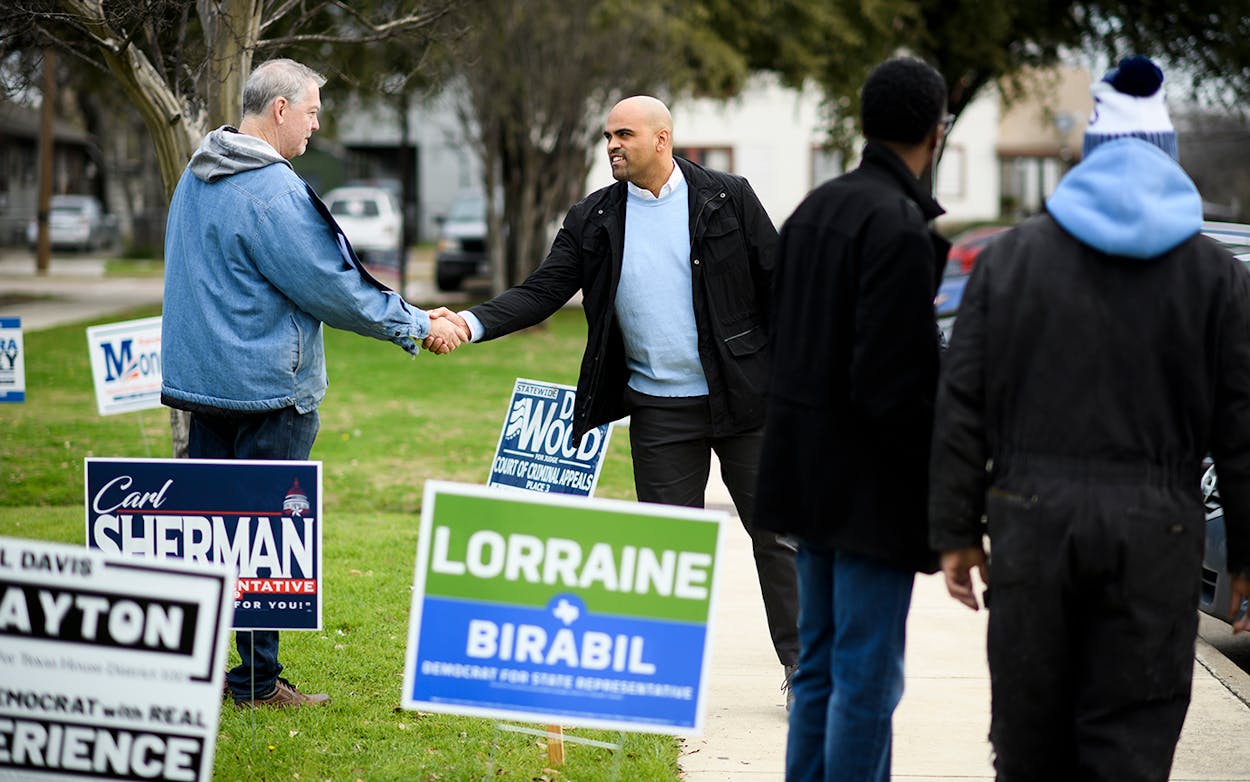Collin County’s reputation as one of the most conservative places in Texas has been long established. In 2010, Tucker Carlson’s website the Daily Caller ranked it sixth on a list of “America’s Top 20 Most Conservative-Friendly Counties,” while these days, conservative Californians, looking for a home that was a better match for their ideology than the West Coast, have sought it as a destination. In the state’s early voting period over the past two weeks, roughly 22,000 more voters turned up than in the same stretch in 2018, with 21,000 of them voting in the Democratic primary, more than doubling the number who voted to determine the party’s candidates in 2016 or 2018. For Democrats this could be a big deal. They see the previously ultraconservative suburbs along I-35 as their path to reclaiming power in the state, so the possibility that the bulk of the new voters in Collin County might be inclined toward their party is a tantalizing prospect.
Nearly 7 percent of registered voters in Collin County voted early in the Democratic primary, up from about 3.5 percent in both of the two most recent elections. That’s a virtual tie with the GOP primary. Republicans saw 606 more early voters than the Democrats, out of more than 82,000 total votes cast. The closing of the balance could suggest a dramatic shift in the makeup of the electorate in a county where Wendy Davis lost by 33 points in 2014, Hillary Clinton lost by 17 points in 2016, and Beto O’Rourke lost by just 6 points in 2018.
Of course, reading too much into the numbers might be overstating the Democrats’ case. The Democratic primary is a hotly contested national race that has garnered endless media attention for more than a year, while the GOP’s, especially in Collin County, has little to motivate voters to the polls. The bulk of the county doesn’t even have a Republican congressional primary to vote in (a sliver of it to the east will weigh in on a challenger to Democratic incumbent Colin Allred, who won his race in 2018 while losing in Collin County by 13 points). But Democrats might still find the early vote encouraging: the last time both overall and early vote turnout in a Democratic primary in Collin County was this large was 2008, because of a similarly high-stakes contest between Hillary Clinton and Barack Obama—and the sky-high engagement in that primary foreshadowed national success for the party in November.
To summarize: nearly 22,000 voters in Collin County who didn’t participate in early voting in the 2018 primary turned out this year, and 96 percent of them voted in the Democratic primary. That might be due to heightened interest in the Democratic race, rather than a shift in the makeup of Collin County’s electorate. But either way, Democrats are probably happy.
Collin County might be the most interesting story from early voting, but it’s not the only one. The high-water mark for turnout in a Democratic primary in most parts of the country is the extremely contentious 2008 battle between Clinton and Obama, and that’s true in most of the largest counties in Texas, too. However, there are a few places where the early vote totals among Democrats have surpassed 2008 total numbers already. Fort Bend County—one of the targets for Democrats looking to flip the state House, despite unsuccessful returns in a January special election—surpassed the 2008 record by a tiny margin (104 votes), while Denton County, next to Collin, saw its Democratic turnout surpass the record by more than 5,000 votes. The Democratic stronghold of Travis County, long one of the highest-engagement parts of the state in terms of voter turnout, also topped its 2008 record by more than 10,000 votes. Those are all raw vote numbers—in terms of percentage turnout of eligible voters, 2008 is still king—but there are nonetheless some records being set by the early vote turnout in parts of the state. The increased raw turnout probably reflects a handful of things, including growing populations, shifting demographics and voter identities, and the high interest in the current primary.
In all, the early vote distribution reflect the highest hopes for Democrats in the state—that the party could narrow the gap in places like Collin, Denton, and Fort Bend counties, and run up the score in liberal strongholds like Austin, Houston, Dallas, and San Antonio, all of which have seen turnout surpass every post-2008 race. Last week, the Democratic National Committee officially added Texas to its list of battleground states it intends to spend money in this fall, which tells us those hopes are shared nationally. It’s almost always a mistake to read too much into early vote turnout and primary numbers, in terms of what they mean for what sort of electoral results each party might expect in November. But what we do know is that we haven’t seen this kind of interest in a Democratic primary in Texas in more than a decade—and the interest is extremely high in parts of the state that Democrats are hoping will be swing districts in November. What that ultimately means for Texas, we’ll learn in a few months.
- More About:
- Politics & Policy








